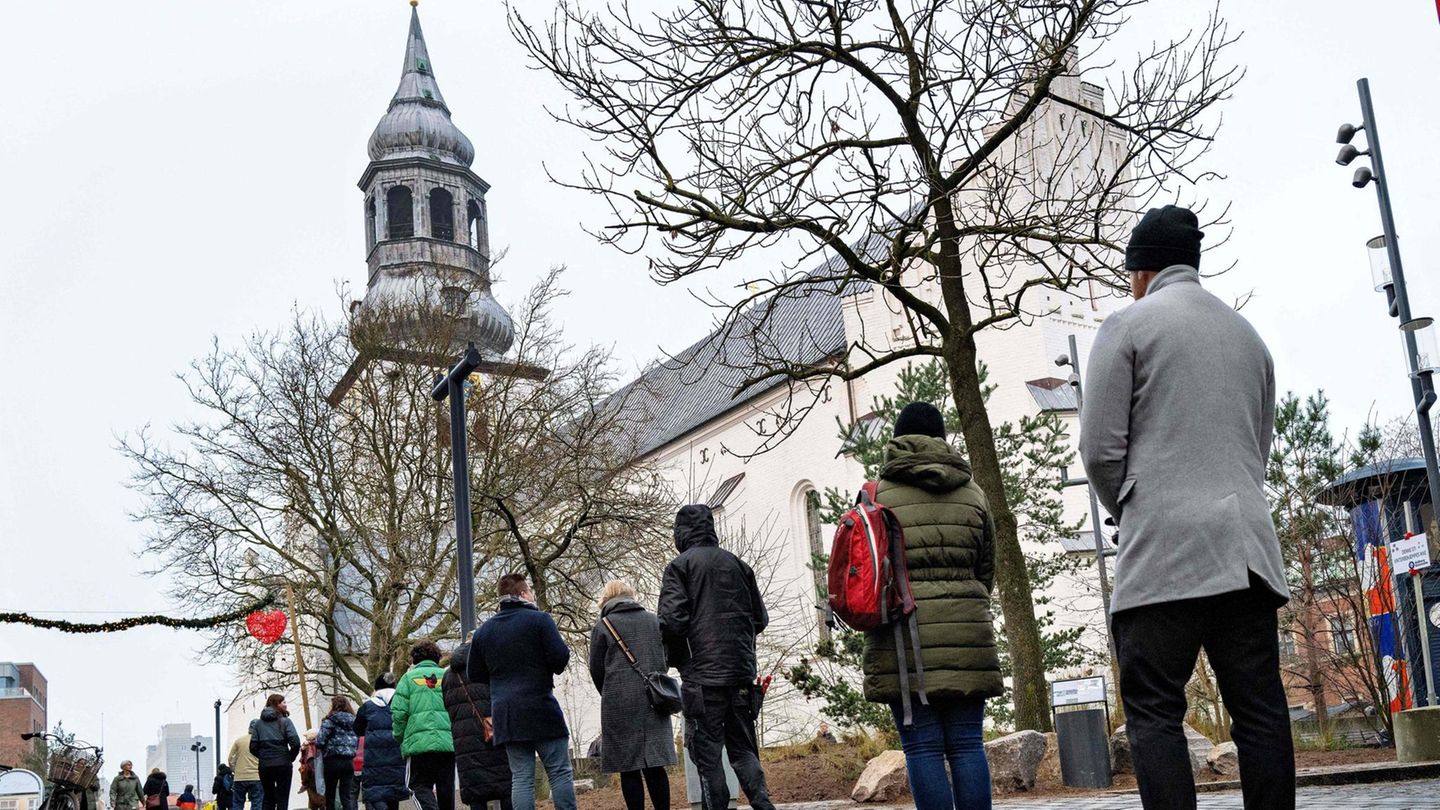Denmark is in the middle of a violent omicron wave. The authorities now reported 18 deaths in connection with the corona variant for the first time. Nevertheless, the experts from the health authorities see a silver lining on the horizon.
Omikron has Denmark firmly under control. The seven-day incidence on Tuesday was a massive 2033.4. The capital Copenhagen and surrounding municipalities are particularly hard hit. In almost all cases it is an infection with the Omicron variant. On Tuesday, they reported a total of almost 25,000 new cases.
The hospitals are also under great pressure. There are currently 794 corona patients in the Danish clinics – an increase of 24 compared to the previous day (as of Tuesday). 77 of them are in the intensive care unit.
In September Denmark celebrated the end of all corona measures. No masks, no vaccination or test certificates, open discos, major events. But the ecstasy of joy was followed by the bitter disillusionment called Omikron. The mask requirement was reintroduced in many places, including in schools, in trade and in public transport. A corona passport must be shown for body-hugging services such as hairdressers. There is a ban on serving alcohol between 10 p.m. and 5 a.m. Personnel limits for shops and restaurants have been introduced. Clubs and discos, zoos, theaters, cinemas and many other facilities are closed.
So far hardly any Omikron intensive care patients in Denmark
Despite the strict measures, the number of infections is not in sight. Tyra Grove Krause of Statens Serum Insitut (SSI), a Danish health authority, told Danish television broadcaster TV2: “Omikron is here to stay and it will cause the infection to spread massively in the coming month.”
Omikron has also caused initial deaths. On Monday the SSI released one in the country. Accordingly, 18 people died in Denmark as a result of an infection with the virus mutant – with almost 56,000 Omicron infections between November 21 and December 28.
But the SSI figures also contain positive signs: So far, 112 people have been admitted to hospitals with Omikron. Less than five of them had to go to the intensive care unit.
One reason for this could be the one in the Scandinavian country. 78.3 percent of the Danish population is fully vaccinated, more than 49 percent are boosted. Others break down how high the incidences are in those who have been vaccinated and those who have not been vaccinated. This shows that although the absolute numbers are higher among those who have been completely vaccinated, the incidences there are lower. This is also due to the fact that there are significantly more people vaccinated than unvaccinated in Denmark.
Higher incidence of unvaccinated
Among the fully vaccinated, 17,683 new infections and 496 hospitalized were registered on Tuesday. In unvaccinated people, these values were given as 2587 and 220, respectively. In the case of incidences, however, it is the other way round. The incidence in fully vaccinated subjects is 390.8; in unvaccinated persons 512.2. Only the new infections within 24 hours are used here. And at hospitalization, the incidence of vaccinated people is 11 – while it is 43.6 for unvaccinated people.
“It is clear that it is the unvaccinated people who get so sick from the corona infection that they have to be hospitalized. There are not that many unvaccinated adults in Denmark, but they fill a relatively large part of the admission figures.” said department head.
Several experts pointed out, however, that Omikron has so far mainly spread among young people and that there is therefore no data on how sick older people get when they become infected with the variant.
Optimism despite the difficult situation in Denmark
However, the specialists at SSI are also in good spirits with regard to the future course of the Omicron wave and the pandemic. Epidemiologist Grove Krause said: “Omikron will still be a burden on our healthcare system, but all indications are that it is milder than the Delta variant. The risk of hospitalization is half that of Delta. Therefore, the healthcare system can still under pressure when we see high levels of infection spread. ” This is “the challenge in the near future”.
But she also has an optimistic forecast in her luggage regarding the influence of the coronavirus on the lives and everyday lives of Danes: “I think the (virus) will exist in the next two months, and then I hope that it will the infections subside and we can get back to normal life. ” Nevertheless, one still has to rely on corona rules and measures to prevent infections.
In Danish, the SSI department head also said that she expected the Omikron wave to peak at the end of January. From February, the SSI expects that the number of infections and thus the pressure on hospitals will decrease. Grove Krause explained that the vaccination protection with Omikron – even with booster vaccination – is no longer so high. But: “Fortunately, we are protected from serious illnesses, and if Omikron takes a milder course, it means that a very large part of us will get this illness, and then we will get something that is like herd immunity.”
Omikron could be the variant of the virus that could end the pandemic. It could be “the last phase or wave of Corona. At least we can hope so.”
“Everyone has to vaccinate before we can feel safe”
SSI boss Henrik Ullum was also cautiously optimistic. Better said, more optimistic after he announced in December that he didn’t realize that Omikron was going to be milder. He told the Danish newspaper on Tuesday that he was also expecting an Omicron peak at the end of January. “Viruses will continue to exist here, but the infection rates will decrease and thus the burden on our health system will be less,” said Ullum. Vaccines and infections would give the population an immunity that could also protect against possible new variants of the virus.
But the optimistic news at Omikron does not mean that the pandemic will end anytime soon. Eskild Petersen, professor of infectious diseases in the Department of Clinical Medicine at Aarhus University, told the Danish that the uneven distribution of vaccines between rich and poor countries was the reason. “I think we all have to vaccinate before we can feel completely safe.” Petersen therefore thinks that it will be a few more years before the corona pandemic is over.
Further sources: , ,
Source From: Stern




